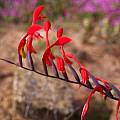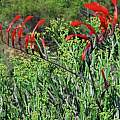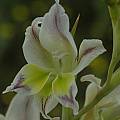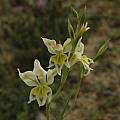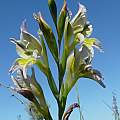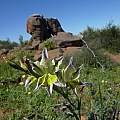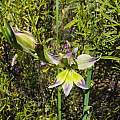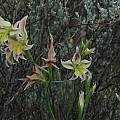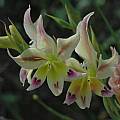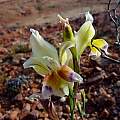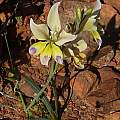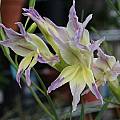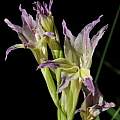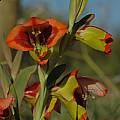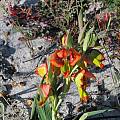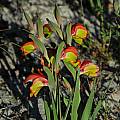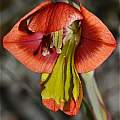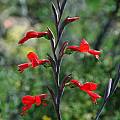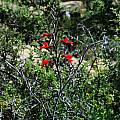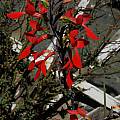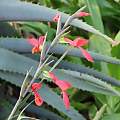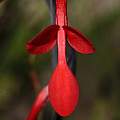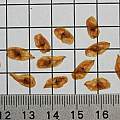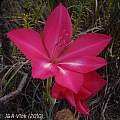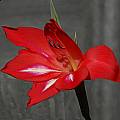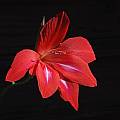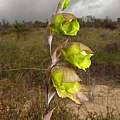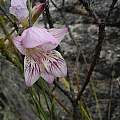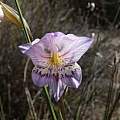Winter rain Gladiolus like their winters wet and mild and may need a dry summer dormancy. They are often less hardy, reaching down to USDA zone 8 at most.
Page 1: G. abbreviatus... Page 2: G. bonaspei... Page 3: G. carmineus... Page 4: G. debilis... Page 5: G. gracilis... Page 6: G. inflatus... Page 7: G. maculatus... Page 8: G. mutabilis... Page 9: G. pulcherrimus... Page 11: G. teretifolius...
Gladiolus saccatus (Klatt) Goldblatt & M.P.de Vos ,formerly known as Anomalesia saccata or Antholyza saccata, extends from the western Cape of South Africa into Namibia. It is found in both summer and winter rainfall areas. It has bright red flowers and is pollinated by birds. This one was growing alongside the road in Namaqualand. Photo #1 taken August 2001 by Mary Sue Ittner. The second photo was taken by Rod Saunders.
Gladiolus salteri G.J.Lewis is a winter-grower found in a small area of granite hills in Namaqualand. It has thin pink tepals, with red and cream chevrons on the lower ones, and is believed to be pollinated by long-tongued bees. You can see a photo of it here.
Gladiolus scullyi Baker is found on silty clay and granite slopes in the northern winter rainfall areas (Namaqualand and western Karoo). It is very similar to Gladiolus venustus but is less colorful with dull yellow to light brown flowers with darker yellow on the lower tepals and darker brown to purplish highlights. The dorsal tepal is also more horizontal, inclined over the stamens and the upper two lateral tepals curve outward in an arc. It is fragrant and windowed in profile. Photos 1-2 taken by Bob Rutemoeller September 2006 near Nieuwoudtville (photos 1-2). Photos 3-5 taken by Cameron McMaster in various locations near Nieuwoudtville September 2011.
Photos 1-2 taken by Bob Rutemoeller September 2006 in Namaqualand. Photos 3-4 were taken by Cameron McMaster September 2011 near Carolusberg in Namaqualand. The last two photos were taken taken by Bob Werra.
Gladiolus speciosus Thunb. is found in deep sandy soils in the Northwest and Southwest Cape. It is similar to Gladiolus alatus with 2 to 8 flowers in a spike, orange marked yellow to greenish and hooded over the stamens. One of the distinguishing characteristics is that it is colored yellow on the reverse. The first four photos taken in the western Cape near Darling September 2006 by Bob Rutemoeller and Mary Sue Ittner. The last photo was taken by Andrew Harvie near Bokbaai in the Western Cape.
Gladiolus splendens (Sweet) Herb., formerly known as Anomalesia splendens, is found in rocky clay, mostly near streams in the Roggeveld and the Calvinia district. The bright red flowers are formed in a strongly inclined spike. Photos 1 and 2 were taken by Mary Sue Ittner near Middelpos September 2006; photo 3 was taken by Bob Rutemoeller in a garden in Calvinia. Photo 4 was taken by Alan Horstmann. Photo 5 was taken by Uluwehi Knecht. Photo 6 by Nhu Nguyen shows the seeds on a 1 cm square grid.
Gladiolus stefaniae Oberm. grows in the mountains of the southern Cape on rocky slopes in gullies that are wet. It grows up to 60 cm. This species flowers at the end of the dry hot summer after the weather has become cooler and it has started to rain. The flowering stem is produced before the leaf. The large flowers are red with a median white streak in the lower two-thirds of the lower three tepals and are pollinated by the mountain pride butterfly. The first photo from the book Plants of the Klein Karoo courtesy of Jan and Anne Lise Schutte-Vlok. The last two photos by Mary Sue Ittner are close-ups of the first flower (of two) blooming September-October 2008 in Northern California. It has continued to flower, but not increase. It usally flowers in California before our rainy season has started.
Gladiolus sufflavus (G.J.Lewis) Goldblatt & J.C.Manning is found on marshy sandstone soils in the Bokkeveld Mountains. Growing from 45 to 70 cm high, it has linear to terete leaves, cross-shaped in section, hairy stems, and pale yellow to greenish bell-shaped scented flowers with dark markings on lower tepals. It flowers August to September. Photo from Rachel Saunders.
Gladiolus taubertianus Schltr. is restricted to the eastern Cederberg and the northern edge of the Cold Bokkeveld in the winter rainfall zone of the Western Cape where plants grow in coarse, stony, sandstone derived ground in well drained sites in dry mountain fynbos. Flowers are pale mauve to slate blue and lightly streaked with purple and lightly sweetly scented. The lower tepals have transverse yellow markings edged with dark purple. Flowering time is August to September. The first photo from Rachel Saunders taken in the Cederberg August 2012 and the second taken in the Northern Cape September 2015.
Page 1: G. abbreviatus... Page 2: G. bonaspei... Page 3: G. carmineus... Page 4: G. debilis... Page 5: G. gracilis... Page 6: G. inflatus... Page 7: G. maculatus... Page 8: G. mutabilis... Page 9: G. pulcherrimus... Page 11: G. teretifolius...
